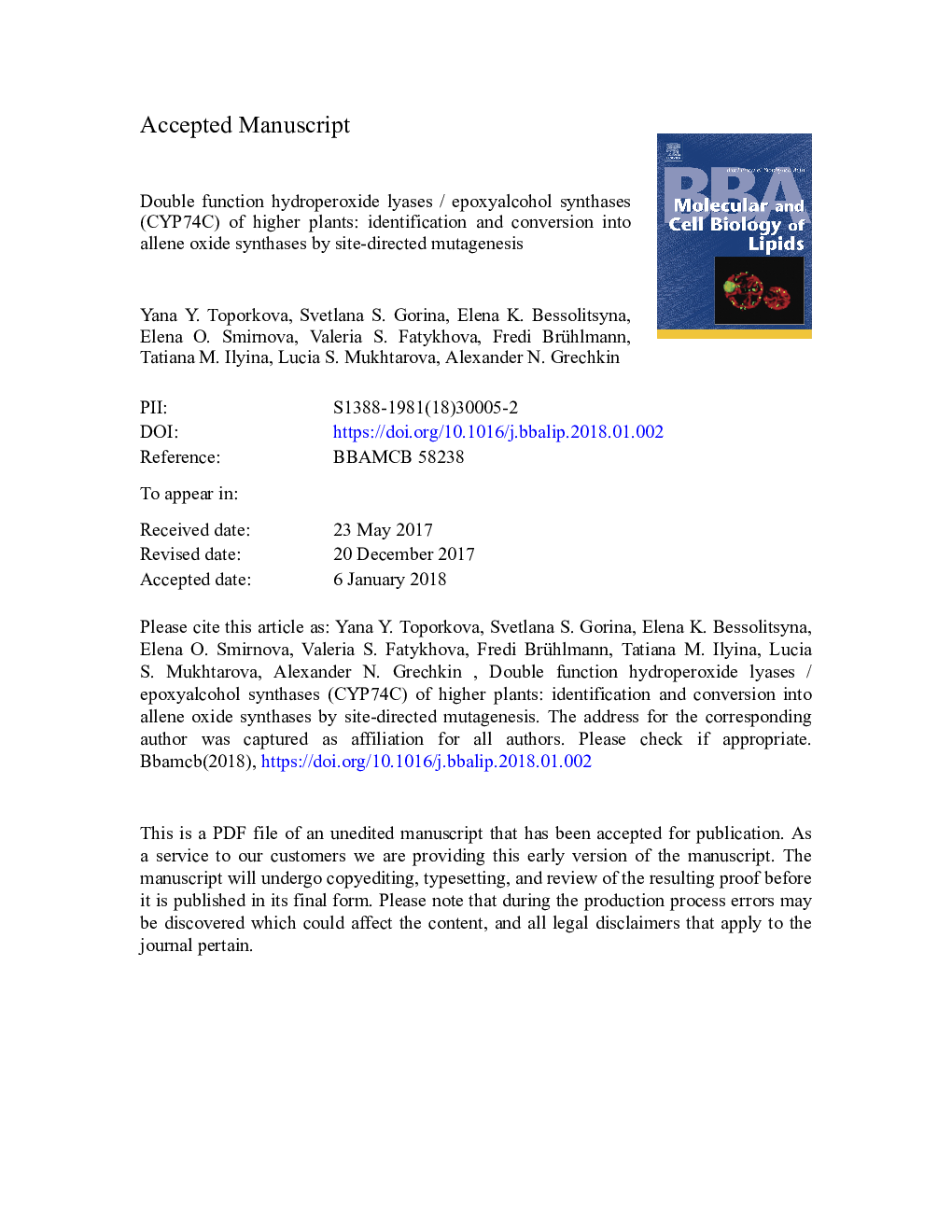| کد مقاله | کد نشریه | سال انتشار | مقاله انگلیسی | نسخه تمام متن |
|---|---|---|---|---|
| 8301361 | 1537679 | 2018 | 38 صفحه PDF | دانلود رایگان |
عنوان انگلیسی مقاله ISI
Double function hydroperoxide lyases/epoxyalcohol synthases (CYP74C) of higher plants: identification and conversion into allene oxide synthases by site-directed mutagenesis
دانلود مقاله + سفارش ترجمه
دانلود مقاله ISI انگلیسی
رایگان برای ایرانیان
کلمات کلیدی
TICTMSOxylipins9-H(P)OD(9S,10E,12Z)-9-hydro(pero)xy-10,12-octadecadienoic acidtrimethylsilylHSQCEASIMACHPL13-H(P)OD(9Z,11E,13S)-13-hydro(pero)xy-9,11-octadecadienoic acidSite-directed mutagenesis - mutagenesis مواجه با سایتDES - ازAOS - بهtotal ion current - جریان یونی کلDivinyl ether synthase - دی دیینیل اتر سنتازEpoxyalcohol synthase - سنتاز اپوکسی الکلAllene oxide synthase - سنتاز اکسید آلنCytochrome P450 - سیتوکروم پی۴۵۰SIM - سیم کارتHeteronuclear single quantum coherence spectroscopy - طیف سنجی تک هسته ای تک هسته ای کوانتومیcorrelation spectroscopy - طیف سنجی همبستگیheteronuclear multiple-bond correlation spectroscopy - طیف سنجی همبستگی چند باند هترونیکی هسته ایMethyl - متیلselected ion monitoring - نظارت بر یون انتخاب شدهHMBC یا Heteronuclear Multiple Bond Correlation - همبستگی پیوند چندگانه ناجورهستهHydroperoxide lyase - هیدروپراکسید لیازCOSY - کثیفImmobilised metal affinity chromatography - کروماتوگرافی وابسته به فلز فلز
موضوعات مرتبط
علوم زیستی و بیوفناوری
بیوشیمی، ژنتیک و زیست شناسی مولکولی
زیست شیمی
پیش نمایش صفحه اول مقاله

چکیده انگلیسی
The CYP74C subfamily of fatty acid hydroperoxide transforming enzymes includes hydroperoxide lyases (HPLs) and allene oxide synthases (AOSs). This work reports a new facet of the putative CYP74C HPLs. Initially, we found that the recombinant CYP74C13_MT (Medicago truncatula) behaved predominantly as the epoxyalcohol synthase (EAS) towards the 9(S)-hydroperoxide of linoleic acid. At the same time, the CYP74C13_MT mostly possessed the HPL activity towards the 13(S)-hydroperoxides of linoleic and α-linolenic acids. To verify whether this dualistic behaviour of CYP74C13_MT is occasional or typical, we also examined five similar putative HPLs (CYP74C). These were CYP74C4_ST (Solanum tuberosum), CYP74C2 (Cucumis melo), CYP74C1_CS and CYP74C31 (both of Cucumis sativus), and CYP74C13_GM (Glycine max). All tested enzymes behaved predominantly as EAS toward 9-hydroperoxide of linoleic acid. Oxiranyl carbinols such as (9S,10S,11S,12Z)-9,10-epoxy-11-hydroxy-12-octadecenoic acids were the major EAS products. Besides, the CYP74C31 possessed an additional minor 9-AOS activity. The mutant forms of CYP74C13_MT, CYP74C1_CS, and CYP74C31 with substitutions at the catalytically essential domains, namely the “hydroperoxide-binding domain” (I-helix), or the SRS-1 domain near the N-terminus, showed strong AOS activity. These HPLs to AOSs conversions were observed for the first time. Until now a large part of CYP74C enzymes has been considered as 9/13-HPLs. Notwithstanding, these results show that all studied putative CYP74C HPLs are in fact the versatile HPL/EASs that can be effortlessly mutated into specific AOSs.
ناشر
Database: Elsevier - ScienceDirect (ساینس دایرکت)
Journal: Biochimica et Biophysica Acta (BBA) - Molecular and Cell Biology of Lipids - Volume 1863, Issue 4, April 2018, Pages 369-378
Journal: Biochimica et Biophysica Acta (BBA) - Molecular and Cell Biology of Lipids - Volume 1863, Issue 4, April 2018, Pages 369-378
نویسندگان
Yana Y. Toporkova, Svetlana S. Gorina, Elena K. Bessolitsyna, Elena O. Smirnova, Valeria S. Fatykhova, Fredi Brühlmann, Tatiana M. Ilyina, Lucia S. Mukhtarova, Alexander N. Grechkin,